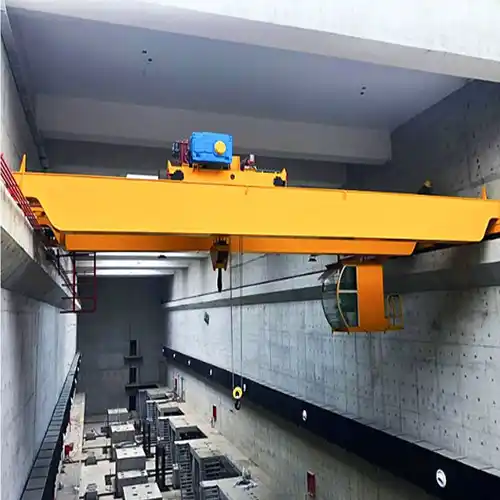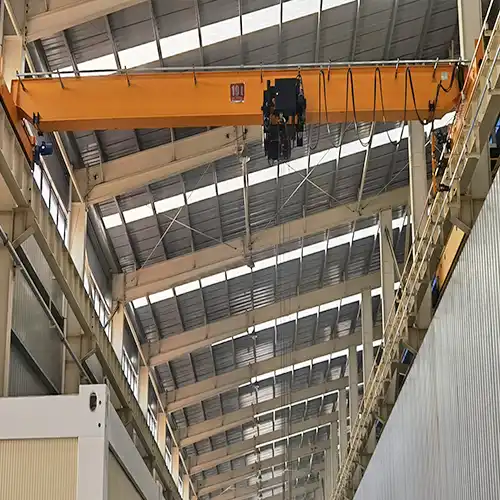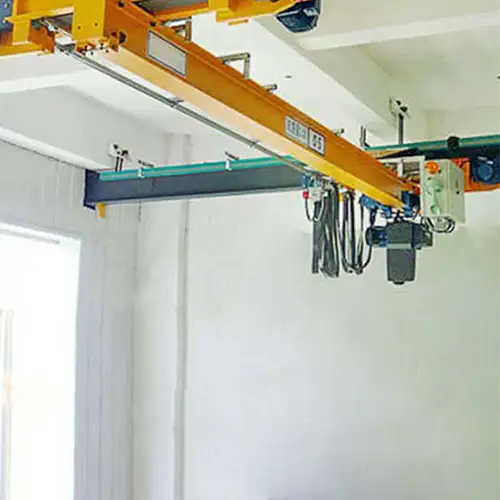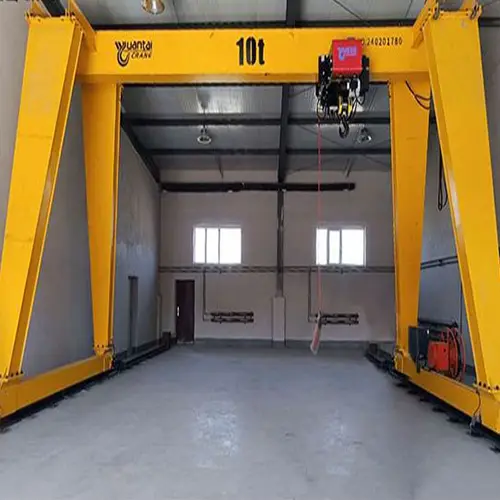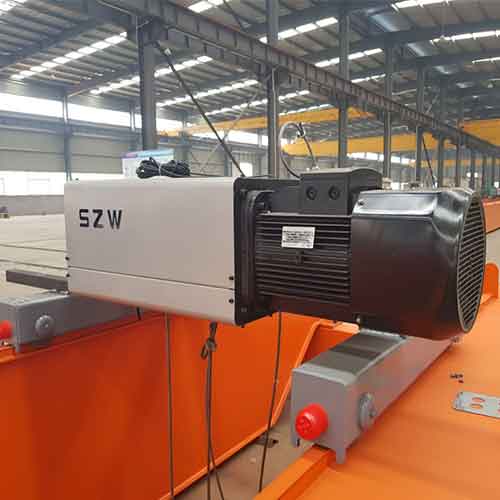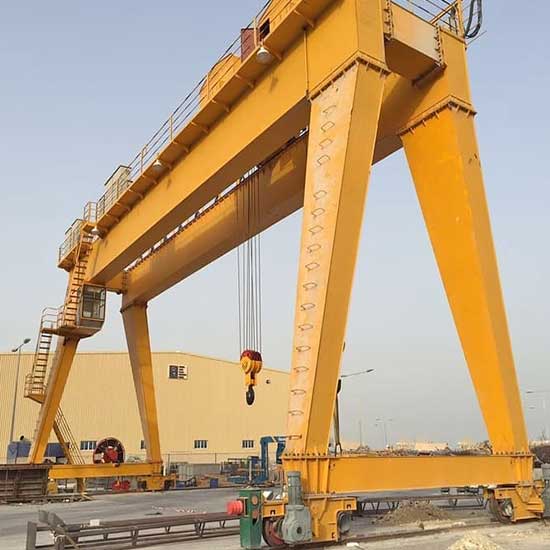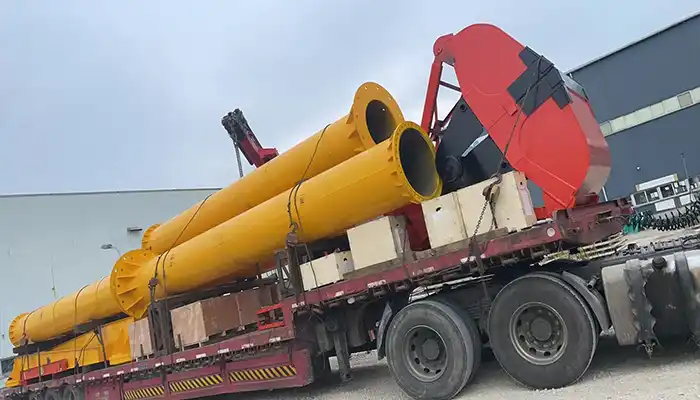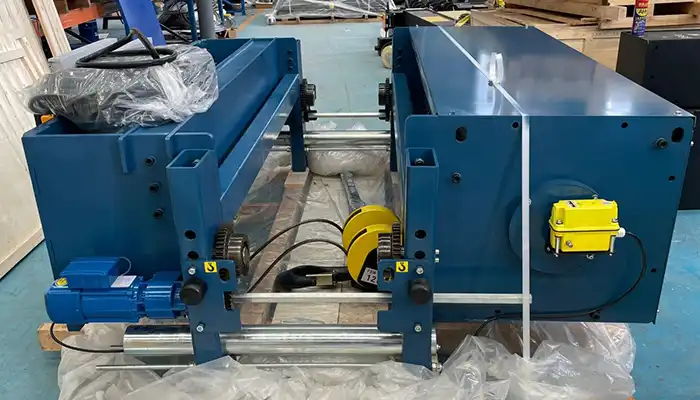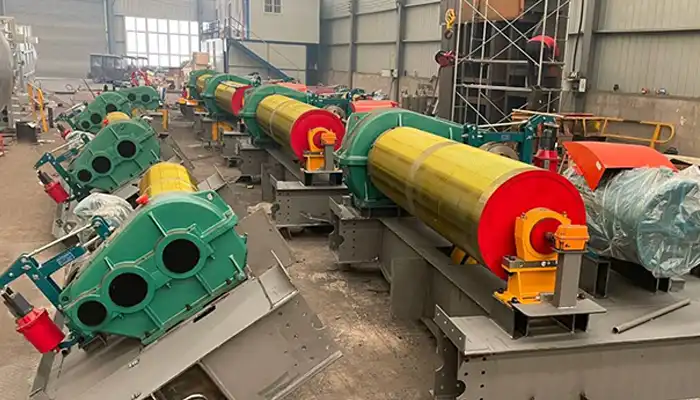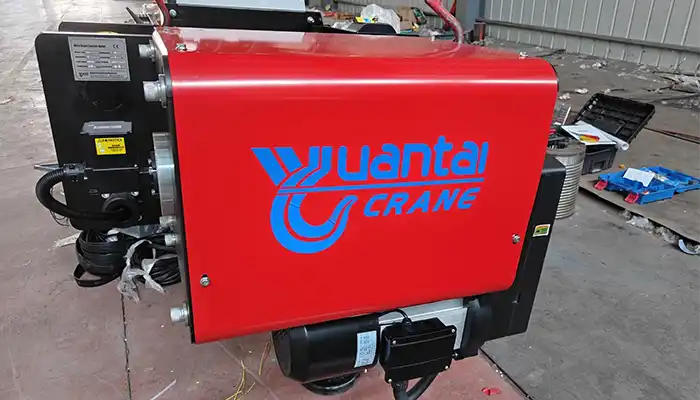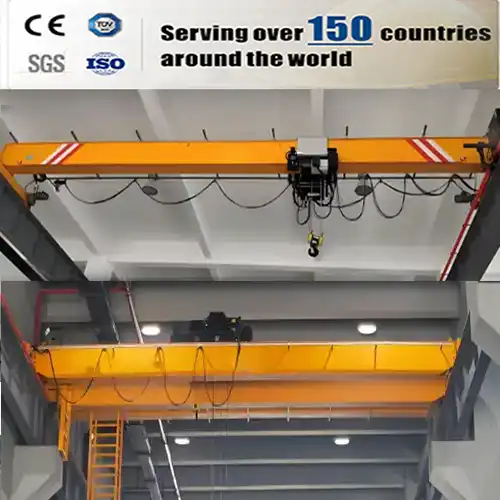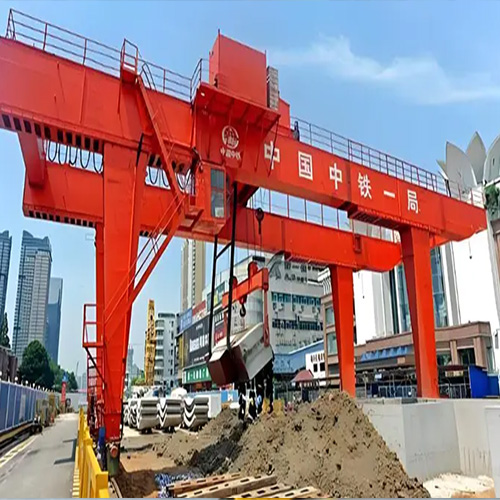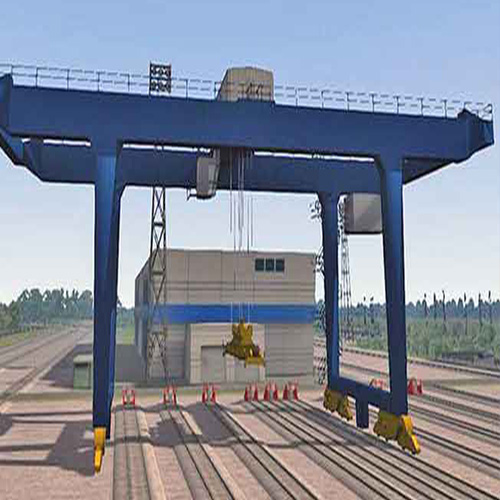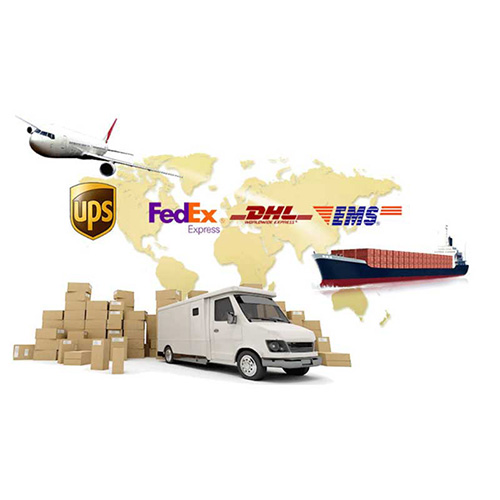Maximize Profit & Minimize Costs: Crane Sourcing from China
Discover how global crane agents can source high-quality, cost-effective single and double girder cranes from China to boost profits
Category: China
Your Trusted Overhead Crane Manufacturer & Supplier
Maximize Profit & Minimize Costs
Ultimate Guide for Global Crane Agents to Source Single & Double Girder Cranes from China
Opportunity for Global Crane Agents
Growing Demand for Cranes Worldwide
The crane market is growing rapidly across the globe. Industries like construction, manufacturing, shipping, and logistics are expanding, leading to higher demand for cranes. As businesses focus on improving efficiency and meeting larger production needs, cranes are essential for lifting heavy loads and maximizing space.
The global demand for cranes is set to increase as infrastructure projects continue to grow, especially in developing regions. This presents a unique opportunity for crane agents to step in and supply businesses with high-quality, cost-effective cranes.
Why Crane Agents Should Pay Attention
Crane agents are in a prime position to take advantage of this growing demand. Buyers around the world are seeking cranes that are not only efficient but also affordable. To stay competitive, crane agents must provide solutions that meet both the quality and cost needs of their customers.
Key Points for Crane Agents:
- Rising demand for cranes in many industries.
- Pressure to reduce costs while maintaining high performance.
- Opportunity to source cranes from China for cost-effective, high-quality solutions.
Sourcing cranes from China offers major advantages. With lower manufacturing costs and a wide range of high-quality products, agents can provide competitive pricing, which is crucial in today's market. This allows crane agents to offer better deals to their customers, while maintaining healthy profit margins.
The Cost Benefits and Profit Potential of Sourcing from China
When crane agents source cranes from China, they can benefit from significant cost savings. Chinese manufacturers produce cranes at a lower cost due to efficient production techniques, large-scale manufacturing, and advanced supply chains. These savings can be passed on to customers, giving agents a competitive edge in the market.
Benefits of Sourcing from China:
- Lower production costs lead to better pricing.
- High-quality cranes with advanced features like energy-efficient motors and safety enhancements.
- Wide product selection including single girder, double girder, hoists, and customized solutions.
This allows crane agents to offer a diverse range of cranes to meet the specific needs of industries such as warehouses, manufacturing plants, and shipping facilities. With access to advanced technology and customization options, agents can provide solutions that improve efficiency and meet global standards.
Purpose of the Guide
This guide is designed to help crane agents navigate the process of sourcing single and double girder cranes from Chinese manufacturers. It will provide step-by-step guidance on how to reduce costs, increase product variety, and improve profits by sourcing efficiently from China.
Key Goals of This Guide:
- Guide agents through sourcing cranes from Chinese manufacturers.
- Maximize profits by reducing sourcing costs.
- Offer customers high-quality cranes with advanced features and reliability.
Understanding the Market Demand for Cranes
Global Crane Industry Trends
The crane market is growing fast across several industries. As businesses expand and construction projects increase, the need for cranes is rising in many sectors. Here's a look at some of the industries driving this demand:
- Construction: With more cities and infrastructure projects being built, cranes are essential for lifting heavy materials and constructing buildings, bridges, and other structures.
- Manufacturing: Factories and production plants need cranes to move heavy parts, assembly lines, and materials efficiently. Cranes are widely used in automotive, steel, and other manufacturing industries.
- Ports: As global trade increases, cranes are needed at seaports and shipping terminals to handle heavy cargo and containers.
- Logistics: Warehouses and distribution centers, especially those focused on e-commerce, rely on cranes for material handling, making these systems crucial for efficient operations.
As industries grow, cranes are also becoming more advanced, with newer models being more efficient, safer, and automated. This leads to greater demand for modern, high-quality crane solutions.
Technological Advancements Shaping the Crane Market
New technology is transforming the crane industry. Some key innovations include:
- Smart Cranes: These cranes use IoT (Internet of Things) technology to monitor performance, predict maintenance needs, and improve safety, helping reduce downtime and increase efficiency.
- Automation: Automated cranes are becoming more common, especially in ports and large warehouses. These cranes can operate with minimal supervision, improving productivity and reducing labor costs.
- Energy Efficiency: Manufacturers are creating cranes with energy-efficient motors and green technologies, reducing operating costs and environmental impact.
- Improved Safety Features: Modern cranes come with better safety systems, including overload protection, anti-collision technology, and load control features to keep workers safe.
These innovations are helping cranes work smarter, faster, and safer, which is driving up demand for advanced crane solutions.
How Agents Can Tap Into Global Demand
Crane agents have many opportunities to benefit from the growing global demand for cranes. Here's how they can tap into the market:
Target Emerging and Developed Markets:
- Emerging Markets: In countries across Asia, Africa, and Latin America, infrastructure projects are booming. Cranes are in high demand in industries like construction, mining, and logistics. Agents can focus on these regions to tap into growing markets.
- Developed Markets: In mature markets like North America and Europe, there's a strong focus on automation and smarter technology. Agents can target industries looking for advanced cranes, such as automated systems for warehouses or cranes with the latest safety features.
Focus on High-Crane-Usage Industries:
- Manufacturing: Industries like automotive, steel, and heavy machinery rely on cranes to move parts and materials. By offering customized crane solutions, agents can secure long-term business in these sectors.
- Warehousing & Logistics: With the growth of e-commerce, warehouses need cranes for moving goods quickly. Automated cranes and material handling systems are in demand, and agents can offer solutions to improve efficiency in these industries.
- Ports & Shipping: Ports require cranes that can handle heavy containers. Agents can target this sector by providing cranes designed for fast and efficient container handling.
By focusing on these high-demand industries and regions, crane agents can tap into a wide range of opportunities and increase their profits in the growing crane market.
This version simplifies the content, breaking it down into clear sections with easy-to-understand points. It highlights the key industries and regions that are driving demand for cranes, and offers practical advice for agents on how to tap into these opportunities.
Why China is the Best Source for Crane Systems
Cost-Effectiveness
One of the biggest advantages of sourcing cranes from China is cost-effectiveness. Chinese manufacturers are known for producing high-quality cranes at a fraction of the cost compared to those from other regions. This is largely due to several factors:
- Lower Manufacturing Costs: Labor, materials, and overhead costs are lower in China, which directly translates into reduced production costs. This allows manufacturers to offer more competitive prices.
- Better Pricing for Agents: For crane agents, sourcing from China means they can access quality cranes at a lower price point, enabling them to offer more competitive rates to their customers while maintaining strong profit margins.
Crane agents can take advantage of these lower costs to stay competitive in the market, offer better deals, and increase sales.
Economies of Scale
China's large-scale production capabilities create significant economies of scale. This means that as the volume of cranes produced increases, the cost per unit decreases. Several factors contribute to this:
- Large Production Volumes: Chinese manufacturers produce cranes in massive quantities, which reduces the cost of materials and production time per unit.
- Efficient Manufacturing Processes: The ability to scale production quickly helps reduce waste and improve efficiency, which ultimately leads to lower prices for the end buyer.
Crane agents can leverage these economies of scale by sourcing in bulk, which can further lower the cost per unit and increase profitability.
Quality Control and Innovation
While China offers cost savings, it does not compromise on quality. Chinese manufacturers are known for meeting high manufacturing standards, and many hold international certifications. This ensures the cranes meet industry safety and performance requirements. Some of the key factors include:
- High Manufacturing Standards: Many Chinese crane manufacturers follow global quality standards, ensuring cranes are reliable and durable.
- International Certifications: Certifications such as ISO 9001 ensure that Chinese manufacturers maintain consistent quality control throughout the production process.
Additionally, China is at the forefront of innovation in crane technology. Manufacturers in China continuously invest in research and development, introducing new features and technologies such as:
- Advanced Hoist Systems: Many Chinese cranes come with state-of-the-art hoist systems that improve lifting efficiency and safety.
- Smart Features: Newer cranes are equipped with smart technologies such as IoT connectivity, real-time monitoring, and automated functions, making them more efficient and easier to manage.
These innovations allow crane agents to offer cutting-edge technology to their customers, increasing their competitive edge in the market.
Wide Range of Options
Chinese manufacturers provide a wide range of crane solutions, offering flexibility in customization and design to meet different industrial needs. Whether the customer requires a basic crane or a highly specialized solution, Chinese manufacturers can deliver.
- Customizations and Configurations: From single girder to double girder cranes, hoists, and end carriages, China offers a diverse selection of crane types and configurations that can be tailored to specific requirements.
- Adaptability to Various Industries: Whether it's construction, manufacturing, or ports, Chinese manufacturers can provide cranes suited to various load capacities and operational needs.
Adaptability to Different Applications: Chinese manufacturers are capable of designing cranes to suit different environments, from heavy-duty construction sites to precision-driven manufacturing plants. Whether it's for handling light loads or heavy-duty lifting, Chinese cranes are customizable to meet any operational demand.
By offering a broad range of options, agents can meet the specific needs of a variety of industries, ensuring that their clients get the perfect crane solution for their operations.
Maximizing Profit: How to Leverage Low-Cost, High-Quality Cranes
Profit Margins
When sourcing cranes from China, it's important to understand how to calculate profit margins effectively to ensure a healthy business operation. Here's how you can calculate your profit margin:
- Cost of Goods Sold (COGS): This includes the price you pay to the Chinese supplier for the crane, including any customization or additional features.
- Additional Costs: Consider all other costs involved in the procurement process, such as freight, taxes, and import duties.
- Selling Price: The price at which you sell the crane to your customers should cover your costs and include a profit margin.
Managing Costs: Freight, Taxes, and Import Duties
When sourcing cranes from China, it's essential to understand the additional costs involved in getting the cranes to your market:
- Freight Costs: Shipping is one of the largest costs in the importation process. Depending on the size, weight, and distance, freight costs can vary significantly. Consider bulk shipping to reduce per-unit costs.
- Taxes: Import taxes vary by country. Be sure to check local regulations to understand how much tax will be levied on the imported goods.
- Import Duties: Like taxes, import duties are imposed by the government based on the crane's value and country of origin. These duties should be factored into the final cost of the crane to ensure you account for all expenses.
By budgeting these additional costs accurately, you can better calculate your overall profit margins and ensure no surprises when it's time to set prices.
Price Optimization
Optimizing your pricing strategy is key to maximizing profit while remaining competitive in the market. Here are some tips on how to do this effectively:
- Competitive Pricing: While sourcing from China allows for low procurement costs, it's important to stay competitive with local and international market prices. Research competitors' prices to ensure you remain attractive to customers.
- Avoid Compromising on Quality: Even though the cost of sourcing cranes from China is low, never sacrifice quality for the sake of a lower price. Focus on the value you offer, including the durability, performance, and after-sales service.
- Volume Discounts: If possible, purchase in larger volumes to reduce the per-unit cost, which will allow you to adjust prices more flexibly.
By carefully adjusting your pricing strategy, you can strike the right balance between profit and competitiveness.
Tips for Negotiating Better Pricing with Chinese Suppliers
Negotiating with Chinese suppliers is a crucial skill that can help lower your sourcing costs. Here are a few strategies to keep in mind:
- Build Long-Term Relationships: Chinese suppliers value long-term partnerships. Building a solid relationship can help you secure better prices, favorable payment terms, and priority for future orders.
- Negotiate Bulk Discounts: If you plan to purchase cranes regularly or in large quantities, leverage this by asking for bulk discounts or reduced pricing based on your volume.
- Flexible Payment Terms: Negotiate payment terms that benefit both you and the supplier. You can request options such as extended payment periods or even lower upfront payments in exchange for a higher order volume.
- Quality Over Cost: Sometimes, suppliers will offer lower costs with less quality. Be firm on the quality you expect and negotiate the price for specific quality features to get the best deal.
Effective negotiation can dramatically improve your bottom line by reducing costs while securing quality cranes.
Selling Points to Clients
Once you've sourced high-quality, low-cost cranes from China, it's time to sell them to your clients. Here are key selling points to emphasize when presenting Chinese cranes to customers:
- Cost-Savings: Highlight how sourcing cranes from China allows for lower costs, which can be passed down to customers without compromising on quality. This will make your offering attractive in competitive markets.
- Durability: Emphasize the durability of Chinese cranes, especially those made with advanced materials and technologies that ensure long-term performance.
- Performance: Showcase the cutting-edge features of Chinese cranes, including smart technologies, advanced hoist systems, and energy-efficient designs that improve efficiency and safety in operations.
- After-Sales Service: Offer a strong after-sales service package. Many Chinese manufacturers provide comprehensive warranty and maintenance services, which can reassure clients about the quality and longevity of the cranes.
By emphasizing these selling points, you can build trust with your clients and demonstrate the value of sourcing from China, leading to increased sales and stronger client relationships.
This section offers actionable insights on maximizing profit when sourcing cranes from China. By understanding how to manage costs, optimize pricing, negotiate better deals, and effectively present the value of Chinese cranes to clients, crane agents can enhance their profitability and grow their businesses.
How to Source Single & Double Girder Cranes from China
Identifying Reliable Suppliers
Finding the right suppliers in China is crucial to ensuring that the cranes you purchase meet quality standards and are delivered on time. Here are key steps to vet reliable Chinese crane manufacturers:
- Reputation: Research the supplier's reputation in the market. Look for reviews, testimonials, and feedback from other agents or companies that have worked with the supplier. A well-established supplier with a solid reputation is more likely to deliver consistent quality.
- Certifications: Check for international certifications like ISO 9001, CE, and others relevant to the crane industry. These certifications ensure that the manufacturer adheres to global standards for safety, quality, and environmental practices.
- Factory Visits: If possible, plan a visit to the supplier's factory. A factory tour allows you to see their production processes firsthand and verify their manufacturing capabilities. If a visit is not feasible, consider using a third-party inspection service.
- Online Resources: Use platforms like Alibaba, Made-in-China, or Global Sources to find credible suppliers. Look at the supplier's years in business, customer ratings, and the certifications listed on these platforms.
By conducting thorough research and checking for these key indicators, you can identify trustworthy suppliers and minimize risks when sourcing cranes from China.
Key Questions to Ask Potential Suppliers
Before committing to a supplier, make sure to ask the following questions to ensure they meet your requirements:
- Lead Times: What are the production and delivery timelines? It's crucial to know the lead time for manufacturing and shipping to plan accordingly and meet customer deadlines.
- Warranty: What kind of warranty does the manufacturer offer? A clear warranty policy ensures that you're covered in case there are issues with the cranes after purchase.
- Support Services: What support services are available after delivery? Ensure that the supplier offers comprehensive support, including installation assistance, technical support, and training if necessary.
- Customization Options: Can the supplier meet your specific customization needs for cranes (e.g., size, capacity, design features)?
- Shipping & Delivery: Who handles shipping and logistics? Confirm the terms, conditions, and who is responsible for shipping and any potential delays.
These questions will help clarify the supplier's reliability, service quality, and ability to meet your business requirements.
Navigating the Procurement Process
Once you've identified a reliable supplier, it's time to place an order and navigate the procurement process. Here are the key steps involved:
- Inquiry: Start with an initial inquiry to gather all necessary details about the crane models, specifications, pricing, and lead times. Be specific about your needs to avoid misunderstandings.
- Quotation: Request a detailed quotation that includes the cost per unit, customization charges, and any additional fees (e.g., shipping, taxes).
- Order Confirmation: Once you agree on terms, confirm the order in writing. The order confirmation should include all agreed details, including product specifications, price, and delivery date.
- Payment Terms: Agree on the payment terms (e.g., 30% deposit, 70% upon delivery). It's important to ensure that you understand the payment structure to avoid cash flow issues. Payments are often made via letter of credit (LC) or T/T (bank transfer).
- Contracts: Draft a contract that clearly outlines the scope of work, delivery schedule, payment terms, and penalties in case of delays or failure to meet agreed specifications.
- Shipping Logistics: Coordinate shipping logistics with your supplier. Ensure that the cranes are packed securely and shipped using reliable carriers. Discuss the shipping method (e.g., sea freight, air freight) and delivery terms (e.g., FOB, CIF).
By following these steps, you can streamline the procurement process and ensure a smooth transaction.
Quality Assurance and Inspection
Quality control is essential when sourcing cranes from China to ensure that the final products meet global standards and are safe to operate. Here's how to ensure quality assurance throughout the process:
Importance of Quality Control: Regular inspections during the production process help ensure the cranes meet safety and quality standards. A good manufacturer should have an in-house quality control team to oversee the entire production cycle, from material sourcing to final assembly.
Third-Party Inspections: Consider hiring an independent third-party inspection service to verify the cranes' quality before they are shipped. These services can check for:
- Welding quality
- Hoist functionality
- End carriage performance
- Load testing
Global Standards: Ensure that the cranes comply with international quality standards, such as ISO 9001 and CE marking, which indicate that the cranes meet rigorous safety and quality benchmarks.
Pre-shipment Inspection: Before shipment, conduct a final inspection to verify that all specifications are met, and the cranes are ready for use. This may include a test run to ensure proper functionality.
By enforcing stringent quality assurance processes and inspections, you can minimize the risk of receiving substandard cranes and ensure that the products you supply to clients are safe, reliable, and high-quality.
Key Features to Look for in Single Girder Cranes
Single Girder Cranes
Design and Application:
Single girder cranes are ideal for lighter loads and smaller industrial spaces. They typically use a single beam (the girder) to support the hoisting system, which makes them compact and cost-effective. This type of crane is perfect for facilities with lower lifting requirements and tight spaces. Single girder cranes are commonly used in smaller factories, warehouses, and service applications.
Benefits:
- Space-Saving: The design of a single girder crane makes it more compact, allowing for better use of space, particularly in smaller facilities where headroom is a concern.
- Simplicity: These cranes have fewer components, which simplifies the design and operation, making them easier to maintain and operate.
- Affordability: Due to their simpler design and lower material costs, single girder cranes are generally more affordable than their double girder counterparts, making them a great choice for budget-conscious clients.
Double Girder Cranes
Design and Application:
Double girder cranes are designed for heavier loads and are better suited for large-scale industrial operations. These cranes have two girders, providing greater stability and strength. They are commonly used in heavy-duty industries such as manufacturing plants, steel mills, and large warehouses that require high-load capacities and greater lifting heights.
Benefits:
- Increased Stability: The dual girder design offers improved stability, allowing the crane to handle significantly heavier loads compared to single girder cranes.
- Larger Lifting Height: Double girder cranes generally provide a larger lifting height, making them ideal for facilities with high clearance needs.
- Greater Durability: With their more robust construction, double girder cranes offer longer service life and are better suited to handle demanding operations and heavier workloads.
Other Important Features
Hoist Types:
The type of hoist used can significantly impact the crane's efficiency and suitability for specific tasks:
- Electric Hoists: Common in modern cranes, electric hoists offer smooth and controlled lifting, making them ideal for frequent and precise operations.
- Manual Hoists: Typically used in smaller or less demanding operations, manual hoists are cost-effective but require more manual effort.
- Chain Hoists: Chain hoists are often used for lighter loads and offer simple operation.
- Wire Rope Hoists: These are suited for heavy-duty applications, providing increased lifting capacity and reliability for high-load operations.
End Carriages and Bridge Kits:
The end carriages are the moving parts of the crane that travel along the runway beams. They play a crucial role in ensuring smooth movement and stability:
- End Carriages: High-quality end carriages ensure that the crane moves efficiently and evenly across the track, enhancing stability and reducing wear and tear.
- Bridge Kits: The bridge kit includes the trolley system, hoist, and other mechanical components that work together to lift and move loads. It's essential to choose a bridge kit that complements the crane's capacity and usage to maximize efficiency and performance.
Safety Features: Safety should always be a top priority in crane design. Here are some critical safety features to look for:
- Limit Switches: These devices stop the crane when it reaches the end of its travel, preventing over-travel and potential damage to the crane or load.
- Overload Protection: Overload protection mechanisms help prevent lifting beyond the crane's rated capacity, reducing the risk of accidents or damage to the equipment.
- Anti-Collision Systems: In environments with multiple cranes or complex operations, anti-collision systems ensure that cranes do not collide with each other, preventing costly damage and accidents.
Managing the Logistics and Shipping Process
Efficient Shipping Solutions
Understanding Shipping Routes, Ports, and Logistics Providers in China:
China is home to some of the busiest ports in the world, such as Shanghai, Shenzhen, and Ningbo. When sourcing cranes from China, it's crucial to choose the right shipping route and port based on proximity to your supplier and destination. Understanding the main logistics providers in China, such as COSCO Shipping, and establishing good communication with them can help ensure smooth shipping processes.
Choosing the Right Shipping Method:
The shipping method you choose can significantly affect both cost and delivery time:
- Sea Freight: This is the most common and cost-effective method for shipping cranes internationally. However, it can take several weeks or even months depending on the route and destination port. Sea freight is ideal for bulk orders of large and heavy items, such as cranes, since it offers the best value for money.
- Air Freight: While air freight is much faster, it is typically much more expensive than sea freight. It's suitable for smaller shipments or situations where time is critical. However, due to the large size and weight of cranes, air freight is rarely used unless the customer requires expedited delivery.
Handling Customs and Import Duties
Key Regulations for Importing Cranes into Different Countries:
Import regulations can vary significantly depending on the destination country. As a crane agent, it's important to be familiar with the customs requirements of the countries you serve. This includes obtaining necessary certifications, registering the import, and complying with any safety or environmental standards that apply to heavy machinery like cranes.
How to Calculate Taxes, Tariffs, and Customs Duties for Your Region:
Every country has its own tax rates, tariffs, and customs duties for imported goods. These charges can vary depending on factors like the weight, value, and classification of the crane. To calculate these costs:
- Research the Harmonized System (HS) code for cranes, which classifies products for customs purposes.
- Contact your local customs office or use online tariff calculators to estimate import duties and taxes.
- Ensure that all duties are paid and included in your overall pricing strategy to avoid unexpected costs or delays during shipping.
Shipping Documentation
Necessary Documents for Crane Importation:
Proper documentation is essential for a smooth import process. These documents are required by customs authorities to verify the legitimacy and compliance of the shipment:
- Bill of Lading (BOL): This document serves as a receipt for the goods and a contract between the shipper and carrier, indicating the terms of the shipment.
- Certificate of Origin: This document verifies the country in which the cranes were manufactured, which is important for calculating tariffs and ensuring the product meets the origin requirements of the importing country.
- Commercial Invoice: This invoice lists the goods being shipped, their value, and the agreed-upon pricing.
- Packing List: This document details the packaging, weight, and dimensions of the items being shipped.
Ensuring All Paperwork is Complete and Accurate to Avoid Delays:
Incorrect or incomplete documentation is one of the leading causes of shipping delays and customs clearance issues. It's essential to double-check that all documents are accurate and match the shipment details. Work closely with your supplier to ensure that the necessary paperwork is prepared well in advance, and always confirm that the documents meet the requirements of the importing country's customs regulations.
Post-Purchase Considerations: Installation, Maintenance, and After-Sales Support
Installation Support
Working with Suppliers for Installation Services or Technical Guidance:
After purchasing cranes, the next step is ensuring proper installation. Many crane manufacturers in China offer installation support or can connect you with certified installation teams. You can coordinate with your supplier to provide these services, or arrange for their technical guidance to ensure the cranes are installed correctly.
- Technical Guidance: If the supplier does not offer full installation services, they can provide technical guidance via video calls, documentation, or on-site consultation. Ensure your installation team understands the specifications and requirements of the crane system to avoid operational issues down the line.
- Training and Certifications for Installation Teams:
Proper training is essential for the smooth installation and operation of cranes. Some suppliers offer training programs for your installation teams, ensuring they are well-versed in setting up the crane and troubleshooting common issues. - Certification: It's important to ensure that your installation team is certified to work with heavy machinery like cranes. Suppliers may provide certification for your team or recommend recognized certification bodies to ensure the team's competency.
Maintenance Plans
- Importance of Offering Maintenance Packages to Clients:
Cranes are heavy-duty equipment that requires regular maintenance to ensure safety and efficiency. As a crane agent, offering maintenance packages can help you build long-term relationships with your clients and generate steady revenue. - Scheduled Maintenance: This includes routine checks, lubrication, and inspection of critical parts like hoists, end carriages, and electrical systems. By offering these services, you can help prevent breakdowns and extend the lifespan of the cranes.
- Partnering with Manufacturers for Spare Parts and Service Agreements:
Establishing strong relationships with Chinese crane manufacturers is key to ensuring the availability of spare parts and services. Many manufacturers offer spare parts packages, and by partnering with them, you can offer your clients a steady supply of replacement components. - Service Agreements: Consider working with the manufacturer to set up service agreements, which may include regular maintenance visits, on-call repairs, and emergency response services. This can add significant value to your offering and enhance client satisfaction.
After-Sales Service
- Building Trust with Clients through After-Sales Support:
A robust after-sales support system is crucial to maintaining strong relationships with your clients. Providing excellent service after the sale shows your commitment to the longevity of the equipment and helps clients feel secure in their purchase. - Customer Support Channels: Establish clear communication channels for after-sales support. These can include phone lines, email support, or even dedicated customer service portals on your website where clients can submit inquiries or request technical assistance.
- Setting Up Communication Channels with Chinese Suppliers for Ongoing Support:
After the crane has been installed, maintaining an open line of communication with the manufacturer is essential for quick problem resolution. Coordinate with your Chinese suppliers to ensure you have direct access to their support teams for technical assistance or replacement parts. - Support Contracts: Consider establishing a formal support contract with the manufacturer for easy access to troubleshooting, upgrades, and product enhancements. This ensures you can offer prompt and efficient solutions to your clients without delays.
Risk Management and Mitigation Strategies
Dealing with Supply Chain Disruptions
Managing Potential Delays and Shortages in the Global Supply Chain:Supply chain disruptions are a common challenge when sourcing cranes from international markets. These disruptions can be caused by various factors, such as political instability, shipping delays, or raw material shortages.
- Diversified Suppliers: One way to mitigate these risks is by establishing relationships with multiple suppliers in different regions of China. This reduces the impact of potential disruptions at a single facility or port.
- Lead Time Planning: It's important to plan for longer lead times and communicate expected delivery dates clearly with your clients. Consider placing orders well in advance of when you need the equipment to ensure that any potential delays can be managed without affecting your business operations.
- Inventory Management: Maintaining a buffer stock of high-demand components or cranes can be a good strategy to ensure you can still meet customer needs if supply chains face delays.
Currency Exchange and Payment Risks
Managing Risks Associated with International Payments and Currency Fluctuations:
When importing cranes from China, dealing with foreign currencies and international payments is a key risk area. Currency fluctuations can affect the final cost of your cranes and impact profit margins.
- Fixed Exchange Rates: One way to manage this risk is by locking in exchange rates with your bank or through financial contracts. This ensures that you pay a fixed amount regardless of market fluctuations.
- Multiple Payment Methods: Utilize a variety of payment methods to ensure flexibility and reduce risks. For example, you can make partial payments upfront and settle the rest upon delivery, or use letters of credit (L/C) to provide additional security for both parties.
- Currency Hedging: In some cases, it might be worth considering hedging options, which allow you to fix the exchange rate for a set period. This protects you from adverse currency movements during the course of your transaction.
Legal Protections
Contracts, Warranties, and Legal Considerations When Sourcing Cranes Internationally:
Sourcing cranes from China requires attention to legal agreements to protect your interests. Contracts, warranties, and legal protections are essential to minimize risk and ensure that both parties fulfill their obligations.
- Clear Contracts: Ensure that contracts with Chinese suppliers are clear and comprehensive. This includes specifying delivery timelines, payment terms, quality standards, and penalties for non-compliance. Contracts should also address ownership, shipping terms, and any guarantees offered.
- Warranties and Guarantees: Warranties are crucial in ensuring that the cranes you import meet the expected quality and performance standards. Be sure that the warranty terms are well-defined, including coverage for repairs, parts replacement, and technical support.
- International Legal Protections: Understanding the legal environment in China and your own country is critical. This includes intellectual property protection, product liability, and dispute resolution processes. Work with legal professionals familiar with international trade laws to safeguard your business.
- Dispute Resolution Mechanisms: Establish clear clauses in your contract regarding dispute resolution. International business disputes can be challenging, so agreeing on arbitration or mediation procedures beforehand can save time and money.
Case Studies: Success Stories from Global Crane Agents
Examples: How Global Agents Have Successfully Sourced Cranes from China and Scaled Their Businesses
Case Study 1: Expanding a European Crane Business with Chinese Suppliers
A European crane agent faced challenges with high procurement costs and long lead times. After partnering with a reputable Chinese manufacturer, they managed to reduce costs by 30% while maintaining high-quality standards. The agent focused on sourcing single girder cranes for smaller clients, which helped them serve a broader market.
Key Strategies:
- Building a strong relationship with the supplier for better pricing and faster delivery.
- Negotiating long-term contracts to secure consistent pricing and supply.
- Leveraging bulk orders to reduce per-unit costs and pass on the savings to clients.
Outcome: The agent expanded their market share in Europe and increased profits by offering high-quality, cost-effective crane solutions to both small and medium-sized manufacturers.
Case Study 2: Growing a U.S. Crane Agency by Entering the Asian MarketA U.S.-based crane agent sought to expand into the Asian market, where there was growing demand for advanced lifting equipment. By sourcing cranes directly from China, the agent reduced overall costs and was able to offer competitive pricing to clients in countries like India and Southeast Asia.
Key Strategies:
- Conducting thorough research on local demand in Asia to identify the right products to offer (such as double girder cranes for heavy-duty industries).
- Partnering with Chinese manufacturers that provided both competitive pricing and after-sales service.
- Using ocean freight to reduce shipping costs and deliver cranes within acceptable time frames.
A crane agent in Latin America faced challenges with supply chain disruptions and costly imports. After establishing relationships with several Chinese crane manufacturers, the agent was able to streamline their operations by placing regular orders and ensuring a reliable supply of components like hoists and end carriages.Key Strategies:
- Developing a strong supplier network in China for consistent and timely deliveries.
- Implementing an inventory management system to monitor stock levels and reduce downtime.
- Offering maintenance packages to clients to generate steady revenue.
Lessons Learned and Strategies Used to Maximize Profit and Minimize Costs
- Building Strong Supplier Relationships:
In all cases, successful agents built long-term relationships with trusted Chinese manufacturers. This approach helped secure better pricing, faster delivery times, and more flexible payment terms. - Leveraging Bulk Orders and Economies of Scale:
By placing bulk orders, these agents were able to take advantage of economies of scale, which resulted in reduced unit costs and higher profit margins. This strategy was particularly effective for high-demand products like double girder cranes. - Understanding Local Market Needs:
Successful agents tailored their product offerings to the specific needs of their target markets. This included selecting the right crane designs, capacities, and features based on industry demand, ensuring they offered competitive and relevant solutions. - Optimizing Shipping and Payment Methods:
By carefully choosing the right shipping methods and managing international payments effectively, these agents minimized additional costs like shipping fees and currency fluctuations, ultimately maximizing their profit margins. - Providing Comprehensive After-Sales Support:
Offering after-sales services, such as installation, maintenance, and support, helped these agents build customer loyalty and generate additional revenue streams. Clients appreciated the extra value added through long-term maintenance agreements and reliable customer service.
Conclusion: Why Sourcing Cranes from China is the Smartest Move for Crane Agents Worldwide
- Lower Costs: Chinese manufacturers offer highly competitive prices due to lower production costs, enabling agents to secure cranes at a fraction of the price compared to other markets. This cost advantage translates into better profit margins for crane agents.
- Higher Quality: Despite the lower cost, the quality of Chinese-made cranes is consistently high, with stringent quality control standards and certifications ensuring reliable performance. Agents can offer cranes that meet global standards while keeping costs manageable.
- Broader Variety of Options: China's diverse range of crane types—such as single girder, double girder, hoists, and end carriages—provides agents with a wide array of products to meet different client needs. This flexibility allows agents to serve a broader customer base, from small facilities to large industrial operations.
Global crane agents can maximize their profits by sourcing from China. By leveraging the combination of low cost, high quality, and diverse options, agents have the opportunity to offer their clients affordable, durable, and efficient cranes. With proper research and strategic partnerships, agents can navigate the procurement process, minimize risks, and position themselves as trusted suppliers in their local markets. The key to success lies in understanding the market demand, negotiating better pricing, and providing exceptional after-sales service that adds long-term value for customers.Take the next step in enhancing your business profitability by sourcing high-quality cranes from China. Connect with reliable suppliers, explore cost-effective options, and start offering competitive, high-performance cranes that will meet the needs of your customers. Maximize your success today by tapping into the world's leading crane manufacturing market—China!
Main Projects
Related Products
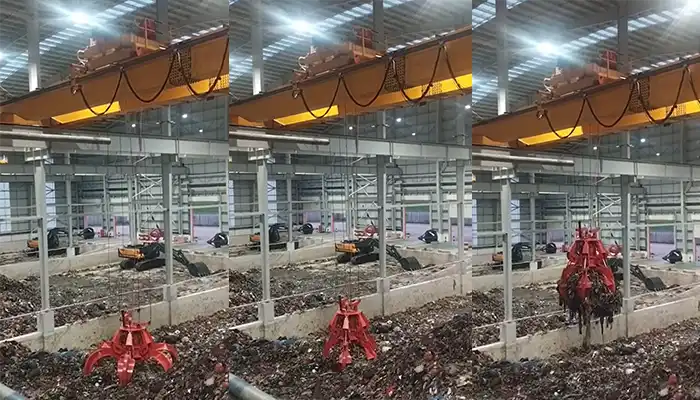
Supplied three grab bucket crane kits to Indonesia, enhancing garbage handling efficiency with high load capacity and reliable performance.
Free consultation to Confirm Parameters & Specifications and Get
Latest Crane Price & Crane Rate.
- Types of overhead cranes : _______?
- Optional: Overhead travelling crane, goliath gantry crane,Slewing jib crane, Single girder or double girder crane,small portable crane or kbk crane, etc.
- Capacity of overhead crane: _______?
- Optional: 0.25ton, 0.5 ton, 1 ton, 2 ton, 3ton, 5 ton, 10 ton,15ton, 20ton, 25 ton, 30ton,35ton, up to 550ton, etc.
- Crane span & lifting height : _______?
- Crane travelling length : _____?
- Control of overhead crane:_______?
- Optional: pendant/ remote/cabin control
- Voltage supply of overhead crane:_____?
- Eg,: 380V50/60HZ,3Phase or others,etc.
- Application/usage of crane:_______?
- Eg,: Steel mill, ,injection mold, cement,stone, concrete,granite, general manufacturing, etc.
Just leave a message via the contact form and our hoist and crane engineer will contact you with in 24working hours.
Get In Touch
